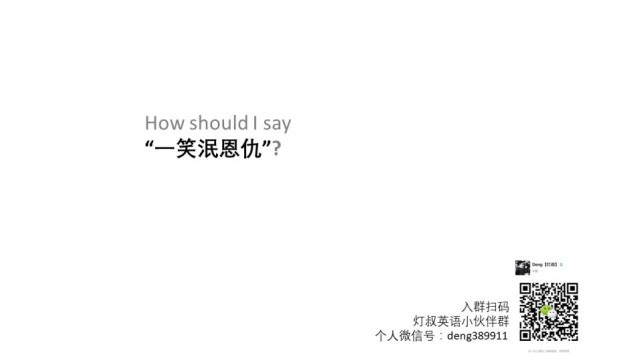2003年9月英语高级口译考试笔试真题+音频+答案
SECTION 5: LISTENING TEST (30 minutes)
Directions: Read the following passages and then answer IN COMPLETE SENTENCES the questions which follow each passage. Use only information from the passage you have just read and write your answer in the corresponding space in your ANSWER BOOKLET. http://tr.hjenglish.com/
Questions 1-3
You're hard at work at the office when the phone rings. It is a stranger, an executive recruiter who says she is aware of your experience in your industry and wants to see if you'd be interested in a "job opportunity." You are told that the job is in your field, in some far-off city, perhaps. You are given a broad description of job duties at a "major consulting firm." But the company's identity is withheld until the recruiter has met you and seen your resume. You hang up feeling a bit flattered - but unsure about how to proceed.
The next step is important: Check the recruiter's credentials. Ideally, this individual should have at least eight to 10 years of experience, specializing in your field. Also try asking about some of the recruiter's recent successful placements. (At least one recruiter says he's always open to naming some "satisfied customers.") If everything checks out, you can e-mail your resume, which the recruiter will then enter into databases it will use to help its clients fill openings. If the recruiter meets arid likes you, she will send you t0 the hiring company. Recruiters estimate that only a half-dozen finalists are picked from an initial pool of a few dozen.
Recruiters can help a job hunter progress in salary and responsibility. Some "contingency recruiters" - paid only after a job is filled - start placing candidates at $50,000 salary or lower. But many more place candidates in jobs with salaries of $70,000 or higher. "Retained recruiters" typically work to fill jobs with salaries beginning at $100,000 or so. "Being recruited really helped me out of a career slump," says Jenny Herring of Des Moines, Iowa. She worked with recruiter Tom Kellerhals, senior partner with the Westminster Group in Chester, S.C., to get a job at Principal Global Investors, a financial-services firm. "I had applied for many, many jobs on my own without success," Ms. Herring says. "[Mr. Kellerhals's] contacts opened the right doors for me and helped me get a great job. He also helped negotiate an attractive salary and relocation package."
Decades ago, recruiters - or "headhunters" - focused primarily on top officials, such as chief executive or chief financial officers. Many placement firms still specialize in filling corner offices. But recruiters today - some 5,000 such firms operate in the US - also comb the ranks of midlevel managers and specialized workers.
In addition to reviewing the resumes they have in hand, recruiters say they also scan news and industry trade publications to learn about promising employees and company reorganizations. Such practices account for many of the "cold calls" received by employees who have not made any moves toward changing jobs.
Between 1992 and 2000, the overall recruitment industry grew by "double-digit percentages" each year, says Joseph Mc-Cool, editor-in-chief of Executive Recruiter News in Peterborough, N.H. Industry growth has since cooled, he says, but he expects a 5 to 6 percent uptick this year. Despite being bombarded with talent in a tightjob market, firms often employ recruiters in order to keep job searches secret, or to locate candidates with specific, hard-to-find credentials. In many cases, human-resources departments are stretched too thin to conduct their own specialized searches. Some recruiters, by contrast, keep continuously updated databases of 50,000 to 100,000 names. http://tr.hjenglish.com/
Should you become one of those names, experts say, find a way to become a standout. "Listen to the recruiter's story [about a givenjob]," says the Westminster Group's Kellerhals. "Try to establish a relationship with a recruiter that would allow the recruiter to easily remember you. A great way to do that is to be helpful.Try to help the recruiter identify other candidates if you've expressed no interest in a job." Job hunters can also contact recruiters themselves using such resources as Kennedy Information's "Directory of Executive Recruiters." The book cites recruiters by industry specialty, region, and most common salary levels. "I wouldn't be overly aggressive,, says Mr. McCool. "It might be perceived as being desperate."
Keep in mind that the recruiter's loyalty is to the hiring firms. "You will only hear from them if they're doing a Search in whichthe job title,job objective, and experience match what is on your resume," says Marilyn Moats Kennedy, managing partner at Career Strategies in Wilmette, III. "They don't work for you. They work for the person who pays them." And companies can be very exacting. "In this economy, the clients are more specific," says Rita Kohn, senior vice president in the Westport, Conn., office of executive-search firm Dawn Taylor Associates, in New York. "It requires a lot of flexibility on the part of even qualified candidates."
1. What is the possible difference between "contingency recruiter" and "retained recruiter"?
2. What are the changes in the job of recruiters over the past decades? http://tr.hjenglish.com/
3. What advice is given in the passage to job hunters in their contact with recruiters?
Questions 4-6
Room 101, the infamous "torture chamber" in George Orwell's novel 1984, is to be preserved as a work of art by the BBC. Orwell, whose real name was Eric Blair, worked for the BBC's Eastern Service during the second world war. He later described his time there as "futile" and likened the BBC to "a mixture of a whorehouse and a lunatic asylum". http://tr.hjenglish.com/
Room 101 of Broadcasting House, thought to have held bad memories for Orwell, featured in 1984as the place where disloyal citizens face their innermost fears. "The thing that is in room 101 is the worst thing in the world," Orwell's hero, Winston Smith, is told by his interrogator as a cage full of hungry rats is placed over his head. "When I press this ... lever the door of the cage will slide up. These starving brutes will shoot out of it like bullets...They will leap onto your face and bore straight through it."
Room 101, at the end of a first-floor corridor in Broadcasting House, is due to be demolished in the summer as part of a massive refurbishment.The BBC has asked Rachel Whiteread, who is best known for producing casts of objects such as the unused fourth' plinth in Trafalgar Square, to tackle the room, which is now packed with pipes, shafts and boilers. "I've been to see it," said Whiteread last week. "I'd like to do something."
The BBC plans to display Whiteread's replica of room 101 in one of several new public spaces in the new-look Broadcasting House. It has already begun to gut the inside of the building as part of a £400m plan to turn it into a huge radio and television newsroom, and a new home for the BBC World Service. About £5m has been set aside by John Smith, the BBC's finance director, to spend on art and design, Alan Yentob, coordinator of the public art project, said:"We've been scandalous overthe past 40 years in not concerning ourselves with art and design in our own buildings." http://tr.hjenglish.com/
Other leading artists, designers and photographers include Anish Kapoor, Fiona' Rae, Cornelia Parker, Nick Danziger, and the comedian Paul Merton asks guests to identify and destroy their pet hates. The Broadcasting House refurbishment is due to be completed in 2006: When it was built 70 years ago, the building, with its many art deco touches, was hailed as a masterpiece of design. Two Eric Gill sculptures –one of Prospero and Ariel outside and another in and Richard Wentworth have agreed to produce work for the art scheme, although the replica of room 101 is likely to cause: most interest. "It sounds fun, all the more so because Orwell hated the BBC," said his biographer Sir Bernard Crick.
This June is the 100th anniversary of Orwell's birth in India. Once in England, the former public-school boy and policeman took up left-wing causes and wrote books such as Coming Up For Air, Animal Farm and Down and Out in Paris and London. However, some experts ask if the BBC has got the right room. "Room 101 was at another BBC building - 55 Portland Place," said Peter Davison, who has published two volumes of Orwell's works, letters and documents. "Portland Place is where they held meetings of the Eastern Service and that, I'm sure, is how he came to name the room in 1984." Whatever the truth of room 101, the BBC plans to continue with Whiteread's cast replica, not least because of the intriguing shapes of its pipes and tubes.
The BBC has made other uses of Orwell's room 101. Its name is the title of the television programme in which the foyer - will be kept because they, like the BBC's Council Chamber, are listed. The public art project will begin in May, with temporary works on the scaffolding and tarpaulin outside Broadcasting House. The permanent works will not be ready until 2006. "I'11 be working on some space project to go inside," said Kapoor, whose enormous pet-like Marsyas sculpture is at Tate Modem. Parker, whose reworking of Rodin's The Kiss is at Tate Britain, plans a work based on sound or pictures.
4. Tell briefly what you know about room 101 and the novelist George Orwell.
5. What does BBC plan to do in order to preserve room 101 as a work of art?
6. What do we learn from the passage about the controversial issue of the location of room 101?
Questions 7-10 http://tr.hjenglish.com/
If you want to understand the future of political protests - or any other grass- roots group activity, for that matter - consider Eli Pariser, 22. The New Yorker was barely old enough to hold candles at his parents' vigils during the Gulf War. Now he's the international coordinator of , an antiwar movement that has four paid staff members and no office but wields enough power to set a major metropolis on high alert. Using nothing more than e-mail and instant messages, Pariser can ask an army of 750,000 protesters to take to the streets whenever he chooses—although the dates are decided by an even larger, equally ad hoc international peace network. On Feb. 15, Pariser's army joined millions of people who demonstrated in cities around the world against the possibility of a war in Iraq. On March 15, they will do it again.
Pariser sits at the nexus of what Howard Rheingold would call a smart mob. Rheingold, a veteran technology watcher and well-published futurist (Tools for Thought, 1985; Virtual Reality, 1991; The Virtual Community, 1993), has put his finger on yet another transformative technology. In Smart Mobs:The Next Social Revolution (Perseus; 288 pages) he describes how large, geographically dispersed groups connected only by thin threads of communications technology - cell phones, text messaging, two-way pagers, e-mail, websites - can be drawn together at a moment's notice like schools of fish to perform some collective action.
Political demonstrations are the classic example, but the action doesn't have to be political or ever take to the streets. More than 400,000 antiwar protesters last Wednesday jammed switchboards in the White House and Congress with a flood of phone calls, faxes and e-mails in what was billed as the first nationwide virtual demonstration. On the same day in Rio de Janeiro, according to Brazilian authorities, a jailed Brazilian druglord known as Fernandinho Beira-Mar coordinated a round of riots, bombs and bus burnings from his prison cell using a smuggled cell phone. http://tr.hjenglish.com/
The original smart mobs were teenage "thumb tribes" inTokyo and Helsinki who punched out short, cheap text messages on primitive cell phones to organize impromptu raves or to stalk their favorite celebrities. (In Tokyo, crowds of teenage fans would appear as if by magic at subway stops where a rock musician was rumored to be headed.) "Texting," as this practice is known, spread like the Hong Kong flu, especially in the developing world. In the Philippines, the black-clad crowds that toppled President Joseph Estrada in 2001 were summoned into being with a now famous single line of coded text passed from phone to phone: "Go 2 EDSA [an acronym for a Manila street]. Wear blck." In Nigeria, the same technology was used to spark anti-Miss World riots that killed hundreds and drove the beauty contest out of Africa. Texting has been slow to take off in the U.S., largely because the service has been relatively expensive and far from ubiquitous. But that's changing rapidly: 27 million American cell-phone users can now send text messages, 50% more than last year. Besides, for most applications, personal computers plugged into the Internet-- especially those with wireless connections - work just fine. Indeed, the computing power sitting on the nodes of these impromptu networks can be harnessed to do a lot more than call out troops for a rally. Rheingold considers the screen savers that millions of computer owners use to donate their spare computer power to search for intelligent life in the universe or more recently, to find a cure for smallpox (see ,org/), as further examples of smart mobs in action. He calls them "supercomputer swarms."
Some of the most powerful smart mobs, Rheingold would argue, can be found on anarchic computer services like the Gnutella network, which replaced Napster as the favored venue for swapping music on the Internet. In these systems, groups of music enthusiasts gather and disperse in a dynamic, unpredictable way that makes it easy for kids to download free music but devilishly has already been transformed——if not mortally wounded——by mobs of music pirates. Government institutions may be relatively impervious to smart-mob technology, but they are probably not immune.
SECTION 6: LISTENING TEST (30 minutes)
Directions: Translate the following passage into English and write your version in the corresponding space in your ANSWER BOOKLET.
许多专家认为,教学改革的当务之急是要改变现在的课程设置和考试办法,不要让孩子只知道“头悬梁, 锥刺股,死读书,读死书”。他们指出,教育改革的关键在于使全社会认识到中、小学教育的目的不只是让 学生掌握必要的知识,更应该提高学生整体素质,特别是他们对于人生意义和社会责任这些根本的问题 要有比较深入的思考。学校要在这些方面深入研究,选择合适的内容和方式引导和帮助学生形成正确的观 点。如果学校只强调知识教育而忽视了人生课程的引导,那么培养出来的只是一批文字或者数字机器,而不是准备进入社会的预备人才。
下页更精彩:参考答案
【点击下载PDF完整版】 【返回口译真题试卷中心】
- 相关热点:
- 英语学习资料
- 中高口真题答案
- 新概念英语从头学第一册











